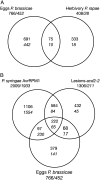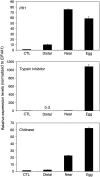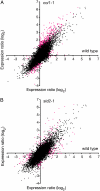Oviposition by pierid butterflies triggers defense responses in Arabidopsis
- PMID: 17142483
- PMCID: PMC1803735
- DOI: 10.1104/pp.106.090837
Oviposition by pierid butterflies triggers defense responses in Arabidopsis
Abstract
Insect eggs represent a threat for the plant as hatching larvae rapidly start with their feeding activity. Using a whole-genome microarray, we studied the expression profile of Arabidopsis (Arabidopsis thaliana) leaves after oviposition by two pierid butterflies. For Pieris brassicae, the deposition of egg batches changed the expression of hundreds of genes over a period of 3 d after oviposition. The transcript signature was similar to that observed during a hypersensitive response or in lesion-mimic mutants, including the induction of defense and stress-related genes and the repression of genes involved in growth and photosynthesis. Deposition of single eggs by Pieris rapae caused a similar although much weaker transcriptional response. Analysis of the jasmonic acid and salicylic acid mutants coi1-1 and sid2-1 indicated that the response to egg deposition is mostly independent of these signaling pathways. Histochemical analyses showed that egg deposition is causing a localized cell death, accompanied by the accumulation of callose, and the production of reactive oxygen species. In addition, activation of the pathogenesis-related1::beta-glucuronidase reporter gene correlated precisely with the site of egg deposition and was also triggered by crude egg extract. This study provides molecular evidence for the detection of egg deposition by Arabidopsis plants and suggests that oviposition causes a localized response with strong similarity to a hypersensitive response.
Figures






Similar articles
-
Insect eggs suppress plant defence against chewing herbivores.Plant J. 2010 Jun 1;62(5):876-85. doi: 10.1111/j.1365-313X.2010.04200.x. Epub 2010 Mar 10. Plant J. 2010. PMID: 20230509
-
Insect egg deposition renders plant defence against hatching larvae more effective in a salicylic acid-dependent manner.Plant Cell Environ. 2019 Mar;42(3):1019-1032. doi: 10.1111/pce.13447. Epub 2018 Nov 19. Plant Cell Environ. 2019. PMID: 30252928
-
Oviposition-induced changes in Arabidopsis genome expression: anticipating your enemy?Plant Signal Behav. 2007 May;2(3):165-7. doi: 10.4161/psb.2.3.3690. Plant Signal Behav. 2007. PMID: 19704745 Free PMC article.
-
Perception, signaling and molecular basis of oviposition-mediated plant responses.Planta. 2013 Aug;238(2):247-58. doi: 10.1007/s00425-013-1908-y. Epub 2013 Jun 8. Planta. 2013. PMID: 23748628 Free PMC article. Review.
-
Chemical, Physiological and Molecular Responses of Host Plants to Lepidopteran Egg-Laying.Front Plant Sci. 2020 Jan 30;10:1768. doi: 10.3389/fpls.2019.01768. eCollection 2019. Front Plant Sci. 2020. PMID: 32082339 Free PMC article. Review.
Cited by
-
Plant elicitor peptides are conserved signals regulating direct and indirect antiherbivore defense.Proc Natl Acad Sci U S A. 2013 Apr 2;110(14):5707-12. doi: 10.1073/pnas.1214668110. Epub 2013 Mar 18. Proc Natl Acad Sci U S A. 2013. PMID: 23509266 Free PMC article.
-
Pseudomonas syringae enhances herbivory by suppressing the reactive oxygen burst in Arabidopsis.J Insect Physiol. 2016 Jan;84:90-102. doi: 10.1016/j.jinsphys.2015.07.011. Epub 2015 Jul 21. J Insect Physiol. 2016. PMID: 26205072 Free PMC article.
-
Plant defense against insect herbivores.Int J Mol Sci. 2013 May 16;14(5):10242-97. doi: 10.3390/ijms140510242. Int J Mol Sci. 2013. PMID: 23681010 Free PMC article. Review.
-
The molecular genetic basis of herbivory between butterflies and their host plants.Nat Ecol Evol. 2018 Sep;2(9):1418-1427. doi: 10.1038/s41559-018-0629-9. Epub 2018 Aug 3. Nat Ecol Evol. 2018. PMID: 30076351 Free PMC article.
-
Responses to larval herbivory in the phenylpropanoid pathway of Ulmus minor are boosted by prior insect egg deposition.Planta. 2021 Dec 8;255(1):16. doi: 10.1007/s00425-021-03803-0. Planta. 2021. PMID: 34878607 Free PMC article.
References
-
- Aplin RT, d'Arcy Ward L, Rothschild M (1975) Examination of large white and small white butterflies (Pieris spp.) for presence of mustard oils and mustard oil glycosides. J Entomol Ser A 50 73–78
-
- Balbyshev NF, Lorenzen JH (1997) Hypersensitivity and egg drop: a novel mechanism of host plant resistance to Colorado potato beetle (Coleoptera: Chrysomelidae). J Econ Entomol 90 652–657
-
- Bartsch M, Gobbato E, Bednarek P, Debey S, Schultze JL, Bautor J, Parker JE (2006) Salicylic acid-independent ENHANCED DISEASE SUSCEPTIBILITY1 signaling in Arabidopsis immunity and cell death is regulated by the monooxygenase FMO1 and the nudix hydrolase NUDT7. Plant Cell 18 1038–1051 - PMC - PubMed

